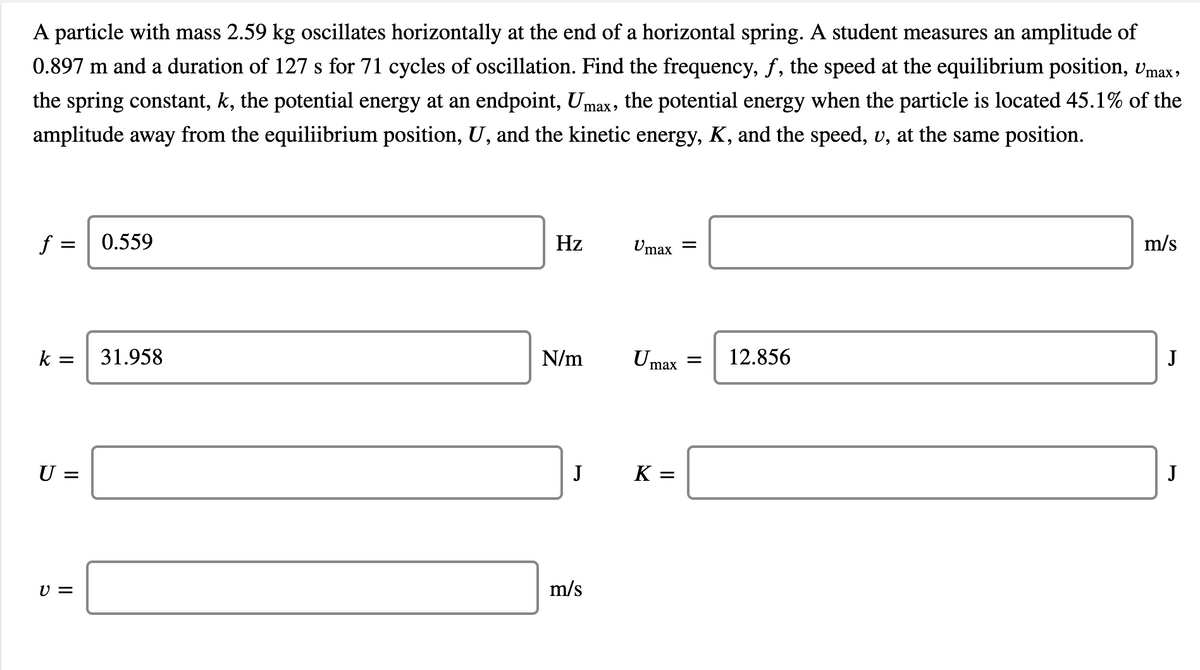A particle with mass 2.59 kg oscillates horizontally at the end of a horizontal spring. A student measures an amplitude of 0.897 m and a duration of 127 s for 71 cycles of oscillation. Find the frequency, f, the speed at the equilibrium position, vmax, the spring constant, k, the potential energy at an endpoint, Umax, the potential energy when the particle is located 45.1% of the amplitude away from the equiliibrium position, U, and the kinetic energy, K, and the speed, v, at the same position.
A particle with mass 2.59 kg oscillates horizontally at the end of a horizontal spring. A student measures an amplitude of 0.897 m and a duration of 127 s for 71 cycles of oscillation. Find the frequency, f, the speed at the equilibrium position, vmax, the spring constant, k, the potential energy at an endpoint, Umax, the potential energy when the particle is located 45.1% of the amplitude away from the equiliibrium position, U, and the kinetic energy, K, and the speed, v, at the same position.
Principles of Physics: A Calculus-Based Text
5th Edition
ISBN:9781133104261
Author:Raymond A. Serway, John W. Jewett
Publisher:Raymond A. Serway, John W. Jewett
Chapter12: Oscillatory Motion
Section: Chapter Questions
Problem 17P: A block of unknown mass is attached to a spring with a spring constant of 6.50 N/m and undergoes...
Related questions
Question
Please help solve for K.

Transcribed Image Text:A particle with mass 2.59 kg oscillates horizontally at the end of a horizontal spring. A student measures an amplitude of
0.897 m and a duration of 127 s for 71 cycles of oscillation. Find the frequency, f, the speed at the equilibrium position, vmax,
the spring constant, k, the potential energy at an endpoint, Umax, the potential energy when the particle is located 45.1% of the
amplitude away from the equiliibrium position, U, and the kinetic energy, K, and the speed, v, at the same position.
f =
0.559
Hz
Umax
m/s
k =
31.958
N/m
U max
12.856
J
U =
J
K =
J
V =
m/s
Expert Solution
This question has been solved!
Explore an expertly crafted, step-by-step solution for a thorough understanding of key concepts.
This is a popular solution!
Trending now
This is a popular solution!
Step by step
Solved in 4 steps

Knowledge Booster
Learn more about
Need a deep-dive on the concept behind this application? Look no further. Learn more about this topic, physics and related others by exploring similar questions and additional content below.Recommended textbooks for you

Principles of Physics: A Calculus-Based Text
Physics
ISBN:
9781133104261
Author:
Raymond A. Serway, John W. Jewett
Publisher:
Cengage Learning

Modern Physics
Physics
ISBN:
9781111794378
Author:
Raymond A. Serway, Clement J. Moses, Curt A. Moyer
Publisher:
Cengage Learning

Physics for Scientists and Engineers: Foundations…
Physics
ISBN:
9781133939146
Author:
Katz, Debora M.
Publisher:
Cengage Learning

Principles of Physics: A Calculus-Based Text
Physics
ISBN:
9781133104261
Author:
Raymond A. Serway, John W. Jewett
Publisher:
Cengage Learning

Modern Physics
Physics
ISBN:
9781111794378
Author:
Raymond A. Serway, Clement J. Moses, Curt A. Moyer
Publisher:
Cengage Learning

Physics for Scientists and Engineers: Foundations…
Physics
ISBN:
9781133939146
Author:
Katz, Debora M.
Publisher:
Cengage Learning

Physics for Scientists and Engineers
Physics
ISBN:
9781337553278
Author:
Raymond A. Serway, John W. Jewett
Publisher:
Cengage Learning

Physics for Scientists and Engineers with Modern …
Physics
ISBN:
9781337553292
Author:
Raymond A. Serway, John W. Jewett
Publisher:
Cengage Learning

Physics for Scientists and Engineers, Technology …
Physics
ISBN:
9781305116399
Author:
Raymond A. Serway, John W. Jewett
Publisher:
Cengage Learning